Salt Lake City may have been, as most of us probably think of it, a quiet, conservative city in the desert without much of consequence happening. If so, a single event, in 2002 changed that. An exhibit of Zimbabwean stone sculpture lost its way to a ‘major’ city and ended up in SLC. The exhibit, with its carving classes, drew out a few colorful threads from the ho-hum fabric of that desert community. Those threads have woven themselves into a tight knit carving group that is sometimes called The SLC Gang of Five.
Behold the Gang of Five plus two pictured here in the Artist Spotlight for March and April. Five of these women will be attending the Roche Harbor Hand Tool Retreat this year on San Juan Island. Silvia, Jonna, and Poonam are brand new members to NWSSA; let’s give them all a warm welcome.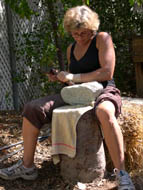
SN: Who are you and how did the Salt Lake City gang get together?
Poonam Soni: Salt Lake City is my home now, but I’m from India originally. Being a beginner in stone carving, I’ve only done four pieces (and I don’t much like one of them) so, I suppose, you’re really going to have to call me a wannabe.
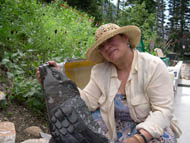
We all came together by taking carving workshops when the Chapungu stone carving exhibit came to SLC from Zimbabwe. There were 7 workshops drawing 80 attendees. Jonna said it was a fluke that it came here because it was supposed to go to Chicago, but that city extended a Dale Chihuly exhibit, so these guys and their incredible sculptures came to Salt Lake City.
The visitors to the exhibit that ended up in our “gang” really hit it off. We had some very interesting people (some might say odd), and we were all really excited about doing something so different.
Jonna was in the film industry when she lived in California.We call Silvia ‘The Reverend Doctor’ because she’s both. Barbara and I were the most boring since we are in different branches of medicine: she’s a radiologist and I’m a child psychiatrist. Ellza came to us from the nearby town of Alta by way of yet another carving workshop. So there you have it. Barbara and I knew each other because we took the same Zimbabwe sculpture class together. Marge met Barbara when some of us took a class set up by Ellza in Alta. Taking so many classes has worked out well for carving together and for socializing.
The thing that unites us is that we all love to carve. Marge does some beautiful small pieces. Silvia does some incredible busts. Jonna has done some very nice faces. Ellza has carved some Shona style pieces. Barbara is on her third piece, certain it will be a fish. The African stones seem to sand well so that when they are polished they are like glass and have a real sheen to them. I think Marge will be bringing some of her leaf carvings to Roche Harbor.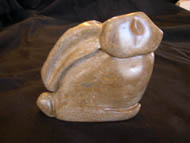
SN: Who are you?
Ellza Coyle: Born and raised in Newport, Rhode Island, I was introduced to Alta, Utah on a ski trip in the mid 1970’s. Finding the life style of the west more in sync with my ways, Alta (only a few miles out of SLC) became my home. Along with my husband, I have been fortunate and we have worked hard to create a life here, owning a local business and home in Alta.
SN: How do you get your ideas, and how do you develop them?
Ellza Coyle: My pursuits in stone carving began in 2002, thanks to the Chapungu Exhibit coming to Salt Lake City, adding to my creative outlets in weaving and clay. I enjoy working in the direct carving style. This means I choose a stone I am attracted to for its color, shape or feel, and may sit with it for a time, seeing what form it suggests to me.
Once an image or idea comes, I begin carving using the entry point it has given me, dialoguing with the stone as it guides me into a completed piece. At other times I may see an image in my mind and locate a stone that resembles the form. I then embark on carving while listening to the stone as it guides me into a more refined shape. Typically I work with various stones from Zimbabwe Africa, while recently I have been flirting with marble. Depending on the need I employ hand and power tools.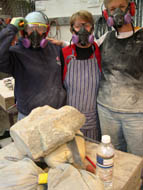
SN: Who and what has influenced your art?
Ellza Coyle: I am very grateful to my teacher, Amos Supuni, a master stone sculptor from Zimbabwe, for all he has shared with me (along with all the other stone-carving friends I have worked with). The time spent over the last three decades in Utah, surrounded by the incredible beauty of the natural environment, offers endless inspiration and seems to have permeated my senses, helping me to create with earth grounding materials such as stone.
SN: How is your work area set up?
Ellza Coil: My studio space is a work-in-progress. About six years ago, prior to my knowledge or interest in stone carving, my husband Bill, purchased a piece of property that houses an old hydro-electric power generation plant, with the intent of resurrecting the facility. He has done that, though it remains a continuous project, a challenge, and an education for him.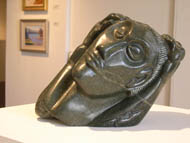
In the middle of this stunningly beautiful site, we have created space for me to have a studio. The creek, used to generate power, is very loud, especially during the spring and summer run off. The yearly snowpack in Little Cottonwood Canyon averages over 500 inches.
This continuous creek noise, along with the noise of power generation, helps to soften the sounds of any power tools I’m able to use. The studio space is situated such that I have an outdoor area to work alongside the creek. It is nestled in gorgeous granite walls, and one of these days I need to learn about carving that granite.
The inside room has a high sloping ceiling, concrete floor and measures about two hundred square feet. Another great feature of this studio location is the use of free power, providing the plant is up and running. Bill performs feats of marvelous magic to keep it going.
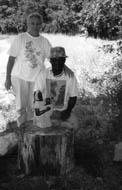
I am hoping that we will manage to get a larger compressor into operation this summer. This could supply us with enough air for my husband’s needs as well as mine, and let us use more than one tool at a time. Plumbing and more electrical outlets are in the plans as well. And if things really go well, heat will be available for next winter. Brrrr.
The building was neglected for many years, and needs a new roof, insulation, and attention on many levels. As finances and sweat equity allow, changes are happening. I am fortunate to have an ideal and inspiring space for a stone carving studio. With patience along with continuing to learn what’s needed, I hope to see the full potential of this space realized. There is still so much in the works, and yet I still get a little zing every time I walk into this marvelous space. How lucky can a stone carver get?
SN: Who are you and what key life experiences affected your direction in art?
Barbara Reid: I am a true native of Salt Lake City, having descended from the Utah pioneers. I am not, however, a practicing Mormon. But since high school, I wanted to be an artist because I could draw and paint.
In school I did not do well with calligraphy and thus I realized my chances of becoming a professional illustrator or designer were limited. I would be dependent on people appreciating my paintings enough to actually buy them. Being a realist, that temporarily ended my budding career as an artist.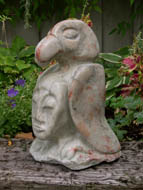
I then decided I would have to find something that would support me in the style I thought I deserved, ending up with a successful, but very demanding career as
a Pediatric radiologist. When the work I loved started to impose on the other activities I wanted to do before becoming too infirm to do them, I retired. That was just last year, and now my friends like to say that I have a loose foot because I have been traveling much of the time.
When I have been home, I’ve enjoyed spending time carving stone with my friends in Salt Lake City. I hope that my side-tracked artistic bent will now have its chance to develop. There’s a pile of rocks in my garage that attest to my interest in carving, but so far most of them haven’t changed much, remaining what they are - rocks.
SN: Have you been influenced by any particular artist?
Barbara Reid: I love the work of Sir Henry Moore, especially his round reclining figures and objects. I have seen his work around the world. I appreciate the African influence on his work. I have thought I should be able to do work like his but my curves and planes do not come out as I see them in my mind. His simple appearing figures and objects are so exquisitely conceived and executed, that I feel there is no one to equal him.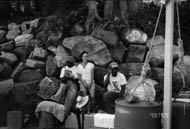
SN: Who are you and what is your life history as it relates to being an artist?
Jonna Ramey: My college training was in filmmaking and graphic art. I created a lot of feminist performance art and environmental sculpture in the early 1970s. For over 30 years I made my living as a film writer and director in San Francisco. Currently I’m working as a freelance writer, photographer, draftsperson, and marketing maven in Salt Lake City. I sculpt stone because my hands have to do it, because sculpting satisfies my need to create, express emotions, and to interact with the world.
SN: What is the source of inspiration of your forms, language, or imagery?
Jonna Ramey: Inspiration for my sculptures comes from several arenas. On the most basic level, I enjoy exercises that teach me about different forms, shapes, stones, tools, and techniques. I am, after all, a beginner. I was initially taught by several Zimbabwean sculptors. As a result, I have been influenced by their techniques, approaches and sculpture. Agnes Nyanhongo remains the Zimbabwean sculptor that has had a lasting influence on my work. (Though I have not yet been able to take a class from her.) I do listen to the stone to hear what it wants to be.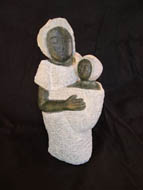
SN: Have you been influenced by any particular artist?
Jonna Ramey: I find that my greatest inspiration and influence has come from journalistic and documentary photography. The works of Sabastio Salgado and the AP photographers in Iraq and Afghanistan have moved me to imagine and create sculpture that reflects my visceral and emotional reaction to the world events they document.
SN: Describe a recent piece or two.
Jonna Ramey: My piece ‘No More Sorrow’ was a direct reaction to a photograph of Salgado’s. His photograph of an African man lying on a cot, wasting away from AIDS and looking directly/defiantly into the camera electrified me. ‘No More Sorrow’ is a beginner’s attempt to express what I saw and felt.
SN: What tools do you use?
Jonna Ramey: I work with both hand and power tools. My first set of tools was handmade by a blacksmith in Utah: a flat chisel, a toothed chisel, and a point. Because my first instructors were Shona artists, I learned to work with whatever was available. My tool bag includes several sticks and nails that I use as tools. My friend Mike Reid created a tool he calls Déjà Vu that is based on a Zimbabwean hand-finishing tool made from automobile spring steel. I use my Déjà Vu a great deal. I use grinders (die and angle) but am not inclined towards pneumatic tools. I struggle with using power tools in a neighborhood backyard setting.
SN: What have been your satisfactions in your life as an artist?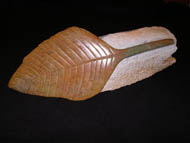
Jonna Ramey: While I often work alone in my studio or back yard, I really enjoy working around other sculptors. I recognize that this is a direct result of the several sculpting workshops my friends and I have organized since Chapungu first brought Zimbabwean sculptors to Utah. Working with people from all walks of life, amiably chatting while chipping at stone, makes for a unique sculpting experience that I treasure.
SN: What are you looking forward to?
Jonna Ramey: I look forward to developing a year-round studio space that will allow me to sculpt in the throes of winter.
SN: Who are you and what is your history as it relates to being an artist?
Marge Neilson: I was raised on a small farm between Cicero and Oso, Washington. At age four, I began to draw flowers, bugs and birds - my mother sent my creations to my brother who was stationed abroad during WWII. He saved my pictures. So today, thanks to my brother, I have a small collection of my earliest works. At age ten, I molded ducks using native clay. I gave them small pebble eyes before drying them in the oven of our wood burning stove.
About 1965, I decided to paint, so I took some lessons and dabbled in oils and acrylics for about ten years. But, the blank canvas always left me clueless, ideas didn’t come easily. I either overworked a piece, or stopped before it was finished. After that came the “craft years” - need I say more?
At age 62, I discovered what I had been looking for all those years...ROCKS! Rocks have always been a part of my life. From early childhood and even now, my pockets must be checked for rocks before my clothes are laundered. I see things in rocks - faces, animals, birds and abstract images. I have always admired, collected, displayed, skipped across water, drawn on, painted on and glued wire sculpture to - rocks. And yes, I’ve hurled a few too. Looking back, it was worth the wait.
SN: How do you get your ideas?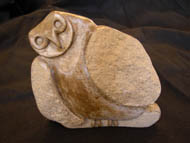
Marge Neilson: On the morning of July 9, 2002, I selected a 40 pound piece of Zimbabwean green opal stone. I thought it would make a nice rabbit. After placing it on my carving stump, I looked at it again and saw a fish! When I turned it, I saw an eagle! From yet another angle, I saw a Native American woman with her baby on her back. I decided that’s what I would carve. Before going home I sketched them on paper, leveled a base and chiseled an outline on my forthcoming master piece. Later at home, I wondered if I had made the right decision. Rabbit? Fish? Eagle? Mother & Child?
The next morning when I began working on my stone I felt a strong resistance to what I was attempting to do. Was the stone trying to tell me something? Then it dawned on me, my stone would still be a woman, but she would be holding her baby in front near her heart. I made a new sketch, adjusted the base and without further resistance from the stone completed my first stone sculpture.
Today, “Kate and little Margaret” proudly adorn my home, greeting me each morning and bidding me peace each evening. My mother’s name was Kate, and as a child I was called little Margaret. This will always be my most treasured piece.
With each new sculpture, I realize more and more that the stone ultimately controls its own destiny. I merely free the inner being.
SN: Describe a recent piece of yours.
Marge Neilson: “Thump, Thump Where’s Who?” is playful. It is both bunny and owl. Although, for one long day, I thought it might be a bunny/bunny, and I would call it “Splitting Hares.” The piece was as fun to do as it is to look at.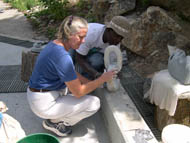
“Thump” is even more unique because of the stone I used. Quarried springstone has an earthy outer crust. This crust looks like a combination of mud and sand. Zimbabwean sculptors prefer springstone for a variety of reasons. It is durable; it is hard, yet hand tool friendly; it holds a sharp edge; it textures well; and it sands, and sands, and sands…. Once polished and waxed, it radiates a deep, almost luscious charcoal to black color. The crust on the other hand is much softer and must be worked gently, however, it to can be sanded and polished nicely. Waxing brings out its earthy ocher color and grainy appearance.
Sculptors usually chip off the outer most layer of the crust because it is too soft. The nearer the hard stone, the harder the crust gets. It’s this contrast that brings out the glowing highlights in the stones dark finish, and that is what sculptors seek.
Moral about that crust - “One man’s castoff is a woman’s treasurer.”

